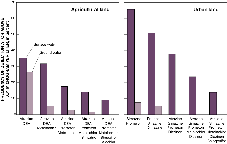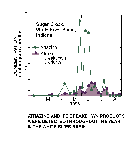
Pesticides usually occur in mixtures of several compounds rather than individually, but most of our experience and research on environmental effects is based on exposure to individual compounds. Therefore, it is vital that we understand and document the occurrence and composition of common low-level mixtures and begin to evaluate their effects.
 |
More than 50 percent of all stream samples contained five or more pesticides, and nearly 25 percent of ground-water samples contained two or more pesticides. In the Central Columbia Plateau, for example, 66 percent of ground-water samples with detections contained more than one pesticide, most commonly in shallow monitoring wells. The most common mixtures were found more than twice as frequently in streams than in ground water, except for the atrazine-DEA combination.
Mixtures of currently used pesticides in stream water may occur in combination with mixtures of organochlorine insecticides in bed sediment and fish. Moreover, about 50 percent of bed-sediment and fish samples with pesticide detections contained compounds from two or more of the major organochlorine groups.
|
HIGH DIAZINON CONCENTRATIONS IN THE SAN JOAQUIN RIVER WERE COMMON FOLLOWING WINTER APPLICATION Diazinon concentrations in the San Joaquin River near Vernalis, California, exceeded concentrations shown to be toxic to aquatic life during January and February 1993--following the winter application of diazinon, a dormant spray applied to control wood-boring insects in almond orchards in the San Joaquin-Tulare Basins. |
Of the thousands of possible breakdown products, few have been looked for in streams or ground water.(6,43) Some are less toxic than their parent compounds, whereas others have been found to have similar or even greater toxicities.
Only seven breakdown products were analyzed in water samples from the first 20 Study Units: 2,6-diethyl-aniline (parent pesticide, alachlor), 3-hydroxy-carbofuran (carbofuran), aldicarb sulfone and aldicarb sulfoxide (aldicarb), DDE (DDT), alpha-HCH (lindane), and DEA (atrazine). Of the parent pesticides, atrazine is the most heavily used, and both it and DEA were widespread in streams and ground water across the Nation. The two were found together in about 35 percent of stream samples and about 25 percent of ground-water samples from agricultural areas.
With few exceptions, most of the other breakdown products were found in fewer than 1 percent of samples in each of the Study Units. However, several breakdown products of alachlor and metolachlor have been frequently found in other studies, often at much higher concentrations than the parent pesticide.(34,44) As NAWQA evolves, more complete analyses of breakdown products are being added as analytical methods and budget constraints allow.
 |
Seasonal patterns in concentrations and occurrences of pesticides in agricultural streams, which tend to repeat each year, correspond to patterns in use and streamflow, including contributions from ground water. Generally, the number and concentrations of herbicides found in most agricultural streams were highest from April through July, whereas insecticides occurred more variably throughout the summer. The spring herbicide pulse was commonly observed in corn-growing areas and other agricultural areas shortly after herbicide application, when herbicides were transported to streams in runoff induced by spring rain and irrigation. In some parts of the Nation, other patterns can occur. For example, some insecticides, such as diazinon in the San Joaquin-Tulare Basins, have patterns of high concentrations during the winter, resulting from the use of dormant sprays on orchards. Differences in patterns also may result from local water-management practices, including the timing of reservoir storage and water use, the timing of runoff from agricultural fields due to irrigation or storms, or ground-water contributions during periods of low streamflow. Seasonal patterns need to be characterized and understood because they dictate the timing of high concentrations in drinking-water supplies and the times when aquatic organisms may be exposed to high concentrations during critical stages of their life cycle. For example, some water suppliers reduce their use of certain surface-water supplies during spring runoff.
| Trends in pesticide concentrations follow changes in use | |
| Insecticides were seldom found in ground water but may be a concern in some areas | |
| The Quality of Our Nation's Water--Nutrients and Pesticides |